Table of Contents
2
CLAY
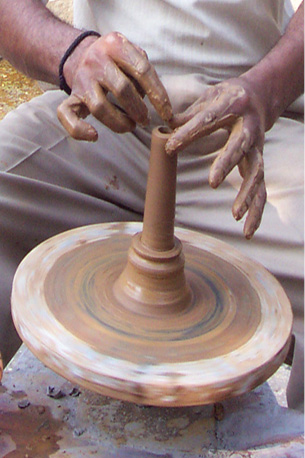
The art of pottery is probably as old as human history. No other art traces the story of human beings on this earth as clearly as pottery does. The tides of time have washed away many civilisations but evidence of their existence remains in fragments of pottery.
There are two reasons why this is true: the first is that clay is found in abundance in practically all parts of the world; the second is that clay objects are the least perishable of all materials.
The history of pottery tells of the daily life of human beings, their death and burial, of human migration, trade and conquest, cultural practices and influences.

Potter shaping a horse-head
As to the discovery of how clay could be manipulated to make pottery, it is easy to imagine how, as prehistoric communities walked through rain-soaked mud, they noticed their footprints and how these impressions became hardened by the wind and sun. Exactly when human beings intentionally used these discoveries for making pottery is unknown but it may have been invented independently in many parts of the world.
However, the process of making a pot is a long and difficult one that has evolved over many generations of trial and experiment.
What is Clay?
Clay is universally found as it forms part of the earth’s crust that developed due to weathering over thousands of years. In India different types of clay are found along riverbeds and banks, lakes and ponds, and agricultural lands. Clay is essentially silica but the varying mineral content in clay adds to its colour and determines how suited it is for different processes.
Clay is cleaned by removing large stony particles, gravel and humus.
When clay is mixed with water it becomes malleable, elastic. Thinner clay solutions can be created to use as paint for walls and on sculptures. By controlling the amount of water that is mixed with clay it can be used in different ways.
♦ It can be made into a creamy compound that can be poured into moulds and allowed to set.
♦ It can be mixed to a leathery consistency and cut like a sponge.
♦ When dry the surface can be scraped off as fine powder.
♦ Straw and grass can be added to create a strong, rough texture ideal for the creation of very large images.
So each artist treats clay differently to suit the type of object that is to be created.
Pottery
Artists, through the ages, have loved clay as it is the most sensitive material on earth for it captures the slightest touch or the gentlest imprint. As soon as the clay object is dried or fired, a chemical change occurs and the object becomes rigid and is no longer sensitive to touch.
Clay of some kind or the other can be found almost anywhere in the world. India, too, has an unbroken continuous history. Artists have used clay to produce objects for the home — cooking pots, roof tiles, clay bricks and sculptures.
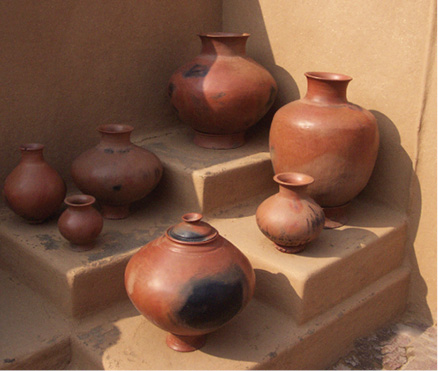
Oh! the pot is everywhere!
Where there is buttermilk, in the cupboard, a pot
Where water is stored, at the waterstand, a pot
Where food is kept, on the stove, a pot
Where there is jaggery, in the attic, a pot.
In the heart of the home,
As ‘gotraj’, ancestors, a pot
Vastu, during house warming,
At the threshold of each home, a pot
Where a marriage ‘pandal’ is built, a pot
When the ‘garba’ dance takes place,
In the courtyard, a pot.
During sickness,
Left in the outskirts of the village, a pot
At every stop in a pilgrimage, a pot
In death, at the cremation ground, a pot
At a ‘Yagna’ representing the planets are pots
In the village square, the singer plays a beat on a pot.
– from Prakriti, Indira Gandhi National
Centre for the Arts
Clay objects are prepared using two basic techniques:
♦ wheel-turned pottery
♦ hand modelling.
A variety of processes within these two techniques have evolved.
Wheel-turned Pottery
The earliest method of making pots for storage may have used the coiling technique. The artist rolls out strips of clay and then places one coil upon another, joining them together with his fingers to form a hollow pot.
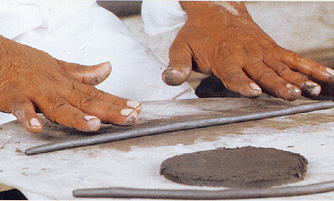
Roll a coil with outstretched fingers.
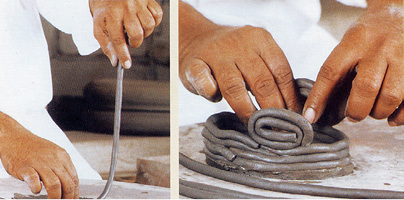
Join and add coils to form interesting patterns.
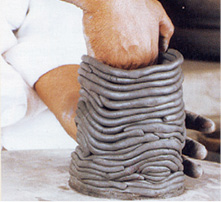
The most important change came with the invention of the potter’s wheel. There are many kinds of wheels used in India today. The first is a simple flat stone or wooden disc that is turned with the hand or a stick. By placing a soft lump of clay on the centre of the disc and turning the wheel the potter can change the shape of the clay. By varying the pressure of her/his fingers and palms she/he can create a pot of different sizes and shapes. By pushing with her/his thumbs down into the centre of the ball of clay and pulling gently outward and upward the shape of the hollow pot takes form.
A potter at his wheel
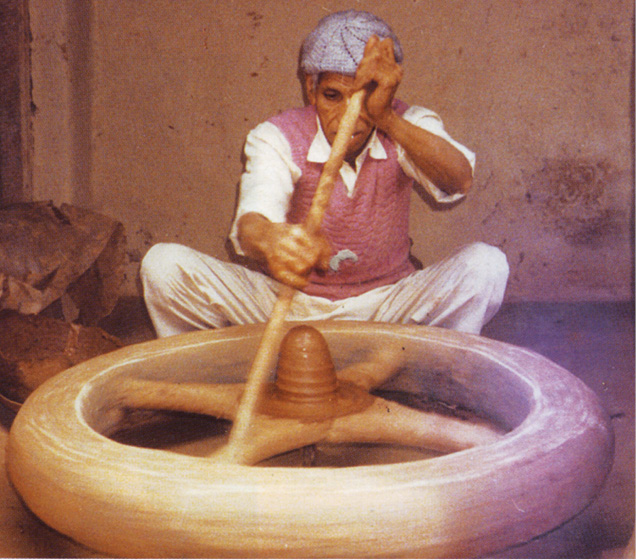
Another type of wheel is mounted on a vertical shaft. By extending the shaft and adding another disc at the bottom it is possible to turn the wheel with the feet, leaving both hands free to make the pot. Today even motorised wheels are used.
Hand Modelling
Modelling is a process used with materials like clay, wax or plaster. Clay modelling enables the artist to work from the inside core to the outside. The artist begins with a well mixed lump of clay and starts working with his fingers to give it shape and form. Clay can be rolled, coiled, pinched and attached to the main form. This technique has several advantages that the artist can use to create a sculpture. He can add legs and arms to the figure by wetting a smaller piece of clay, rolling it and attaching it to the main body.
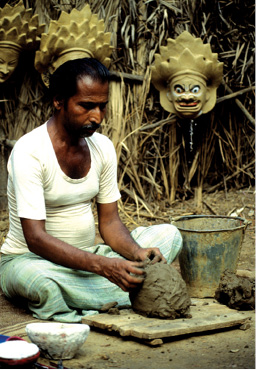
Making clay masks
The process gives the artist freedom to change, modify and repair areas at will. If, for example, the nose of the figure falls off, the artist can just wet the clay piece and stick it back on to the face. He can then continue to add smaller details of hair, bangles and necklaces in clay.
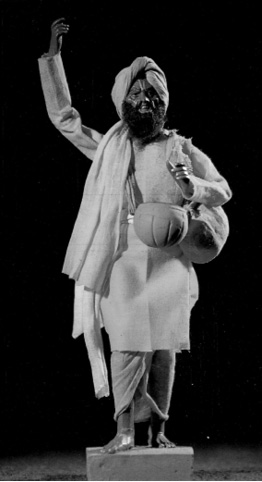
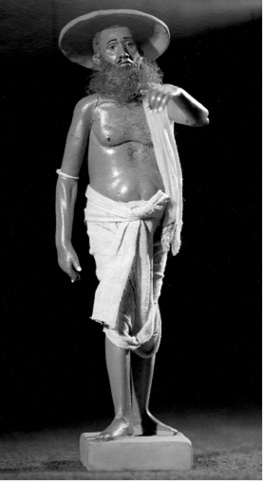
Clay figurines, West Bengal
Decoration: Clay offers endless possibilities to create textures and designs on the wet surface of pots, which can be pressed or imprinted, cut out or added on like appliqué and then many parts of the clay object can be assembled together to forge a cohesive whole.
Painting: After firing, the craftsperson can pour a slip, which is the thin liquid solution of clay that gives the clay object an even colour. The sculpture can be painted with mineral colours to add value to its appearance. Sometimes clay objects such as pots, diyas etc. are also painted.
What Is Terracotta?
Once the clay object is made, it can be dried in the sun and fired in a local kiln made of cowdung and wood. This process transforms the clay into terracotta. Clay can be fired at different temperatures from 700–1400 degrees C. The intensity of heat and the type of firing gives the terracotta its colour and hue that range from dark brown to lively reds.
Once fired, the terracotta becomes insoluble, un-plastic and durable. On firing, the clay loses its chemically combined water, and becomes hard and almost imperishable. That is why 5000-year-old seals from the Harappan Civilisation still exist.
Terracotta: Firing a clay object in a kiln transforms the clay into terracotta.
Making of Giant Figures
Traditional potters live and work in almost every part of India. Pottery is a specialised profession and often the community lives together in a separate section of the village or town.
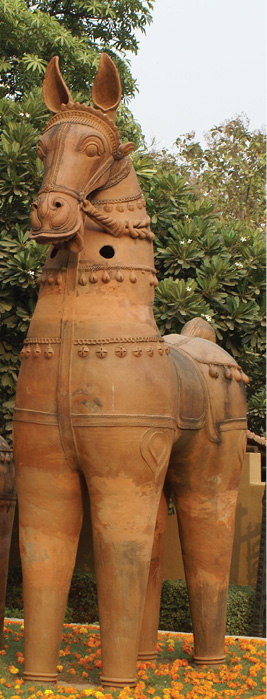
Each potter or kumhar has the skill to create hundreds of pots for different uses — from huge storage jars for grain and water, to tiny oil lamps for Diwali. He can design a child’s toy and sculpt giant figurines for worship as well.
To make giant figures, artists have evolved various techniques. One of them is to make each piece of the figure on the potter’s wheel. This is to prevent the clay figurine from breaking when it is fired in the kiln. When clay is fired, it contracts considerably owing to the loss of water and moisture. A solid model made of ordinary clay would burst under the pressure of the heat of the kiln. A sculpture with uneven wall thickness would warp and crack. Therefore, using the potter’s skill in creating parts of the figure in which the walls are of even thickness is a unique way of overcoming this problem.
The potter throws clay to create the hollow shapes of legs, body and neck of the figure he wants to create. These individual pieces are then assembled by the potter to create the required form. The four pot-shaped legs are attached to the hollow torso. To this the artist adds bits of pinched, pressed and coiled clay for decoration.
This unusual process involves the imaginative use of the material and a great deal of inventiveness goes into making the form both technically sound and aesthetically satisfying. Some of these votive figures are two metres high and their towering presence only adds to the genius of the village potter. Potters make these figures for their patrons in lieu of money or food.

A craftsman finishing an Aiyanar horse
Clay through the Ages


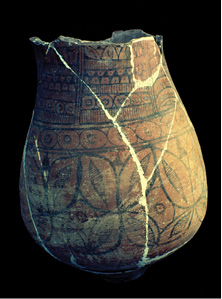
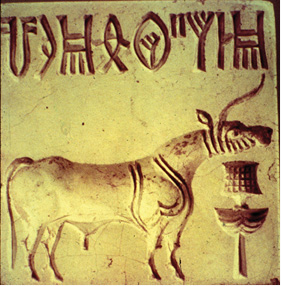
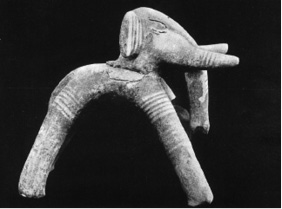



Votive terracotta figures are made in Madhya Pradesh and Chhattisgarh. In Bastar, on amavasya (the no moon night) of Bhadrapad (August to September), tribals offer terracotta bulls, tigers, elephants and horses, sometimes with one or two riders, to the goddess whom they worship for wealth, health and protection from evil spirits. These clay animal gifts or votive offerings have replaced the practice of animal sacrifices of earlier times.
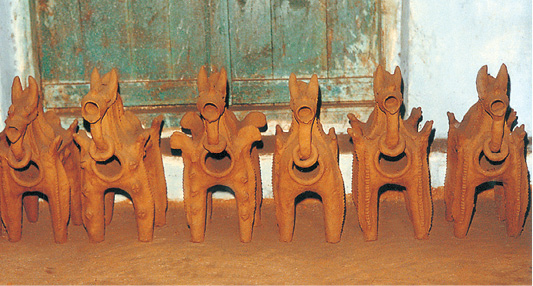
In Tamil Nadu the dramatic larger-than-life size image of Aiyanar, the local deity, is surrounded by a sea of attendants, horses and bulls. They serve as gram devatas who stand at the entrance of the village and protect it.
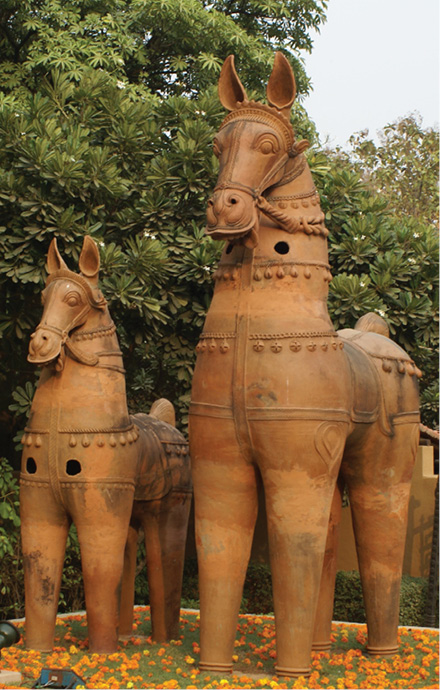
During Durga Puja in West Bengal enormous figures of the goddess are created. The artists use different techniques and mixtures of natural materials to make these excellent stately statues. They follow the traditional practice to create the inner core with local grasses bound together to form the legs, arms and head. The grasses are often swathed with thin cotton cloth. Then layer upon layer of clay is carefully applied to the body of the goddess to gradually build it up.
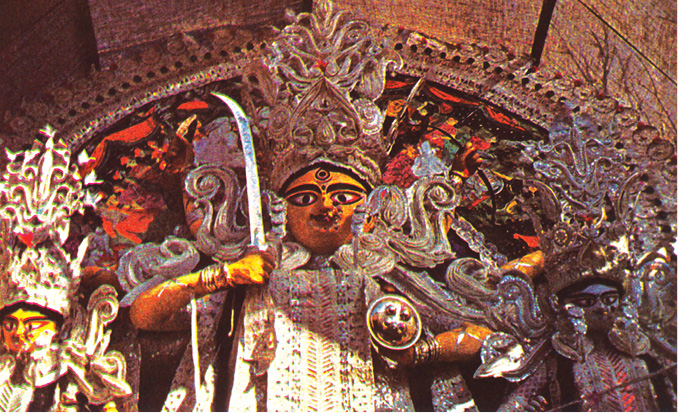
Over a period of several days, each layer is allowed to dry completely so that no cracks appear and there is no warping. Once dry, the entire figure of the goddess is painted with natural mineral colours. After this the figure is dressed in a sari and adorned with jewellery made of paper or artificial jewels, and garlands of flowers, before it is ready for worship.
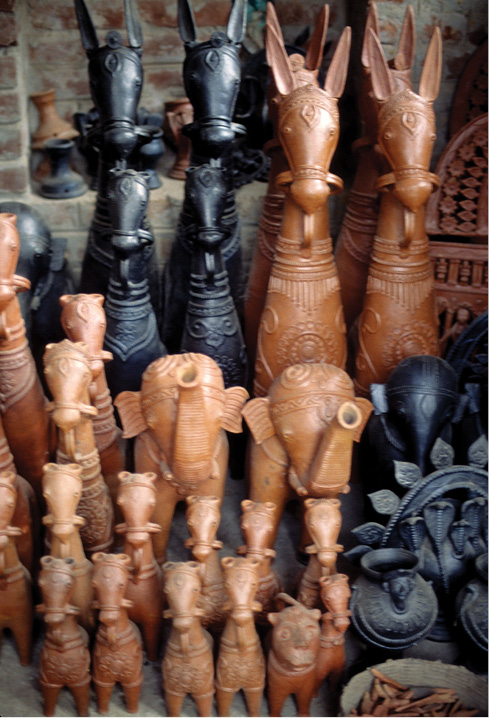
Ornately decorated clay horses, huge armies of terracotta figures and assemblies of village deities with their attendants can be seen under the trees in village grounds in Bankura District, West Bengal.
Mati kahe kumhar se tu kya raundhe mohe,
Ek din aisa ayega main raundhoongi tohe.
– Kabir
EXERCISE
1. No technique emerges in a day. In any craft a technique is sharpened over centuries. What do you think were the various stages that pottery-making went through that led to the use of the wheel in pottery? Describe in detail.
2. In many parts of India water is stored in clay pots. What aspects of the design and material of a surahee or matka make it suitable for storing drinking water in summer?
3. With reference to the photographs given below, identify the different techniques used by the artist to create each.
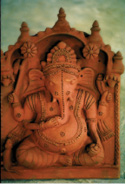
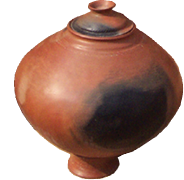
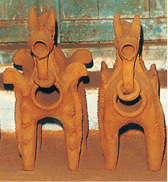
4. The history of pottery tells of the daily life of human beings, death and burial, of human migration, trade and conquest, cultural practice and influence. Survey ten houses in your neighbourhood and create a table of various pottery objects found there giving information regarding when they are used, their shape, how they are used and from where they were obtained. Especially refer to the daily life, rituals, trade and transport in the surveyed households.
5. The invention of the wheel had a profound effect on every apect of human life. Explain the many uses of the wheel and how each has changed human life and culture through the ages.
6. Why, do you think, pottery is a specialised profession from the point of view of skill, tools, techniques and entrepreneurship?
7. On the Internet, search for new uses of clay—in industry, in homes, in science, in space travel etc.
8. Artists, poets and writers, through the ages, have used the image/metaphor of pottery. Find examples to illustrate the concept in Indian art and literature. Create your own poem using clay as a symbol.